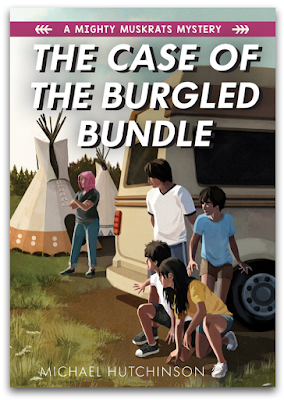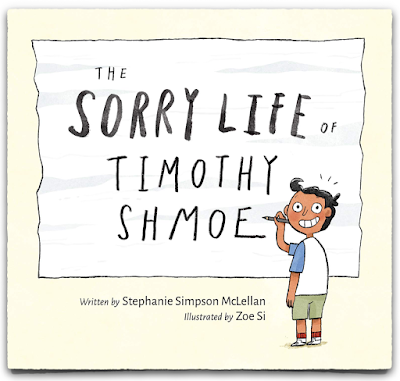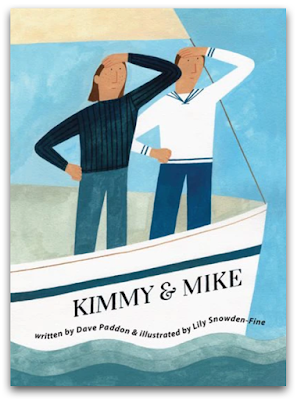Written and illustrated by Jon Klassen
Candlewick Press
978-1-5362-1563-2
96 pp.
Ages 4-8
April 2021
After
yesterday's review of
Jon Klassen's picture book,
The Rock from the Sky, I had the pleasure of interviewing the author-illustrator about his newest creation. Here is that Q & A.
 |
Jon Klassen, author-illustrator of The Rock from the Sky
|
HK: Between the little hats worn by Turtle and Armadillo, and the rock hanging in the air, I suspect that you’re a fan of the surrealist artist René Magritte. Is this actually the case or is there another influence that inspires your art?
Jon Klassen: I am a Magritte fan for sure – I don’t think I used to be, but I’ve come around – though the hats and the rock have other sources too. The bowler hats I think do a few jobs, referentially – Magritte, but also Laurel and Hardy, since I think of these stories as kind of like little comedy skits, and also Samuel Beckett’s Waiting for Godot. I’m not positive they wore bowler hats in that, but it feels like they did, and Beckett’s work generally has been a big deal for me. The rock itself is very Magritte, I agree, though there’s a weird reference for that one too – the first Edward Gorey drawing I remember seeing was on the cover of an edition of The 39 Steps by John Buchan and it’s just a drawing of a huge rock hanging in the sky over a flight of stairs going down a cliff, and it had a really big effect on me. I still love that drawing.
HK: Was the germ of an idea from which The Rock from the Sky arose Magritte’s work The Castle of the Pyrenees or something else altogether?
Jon Klassen: I think it actually arose mostly from a talk I heard Alfred Hitchcock give on the nature of suspense, and how you could make an interesting scene out of a group of people sitting around a table talking about something very boring if you had told the audience ahead of time that there was a bomb under the table that would go off in 5 minutes. I enjoy drawing characters doing next to nothing, but I need some sort of setup that gives me permission to have pictures like that, so the rock from the sky was my “bomb under the table.” I really have been drawing rocks for like 15 years just hoping there will be a story for them some day. The back cover of the book, and the spreads where it’s just the rock in the sky, are kind of why I started the book in the first place.
HK: Though there are only three characters–Turtle, Armadillo and Snake–and minimal dialogue and action, they are clearly distinct, especially Turtle and Armadillo. Why choose a turtle, an armadillo and a snake for your characters in The Rock from the Sky?
Jon Klassen: They were kind of intuitive choices. I wanted this book to kind of connect with the other books I’d done, almost like the bit players from those books that finally got to put on their own show. The turtle was useful, practically speaking, since he moves slowly and it helps contrast with the rock falling. The armadillo-type guy just looks kind of humble, but also I think of him as kind of a man alone, out in the sticks a little more, so maybe he’s wise that way, kind of knowing. The snake just made me laugh. Snakes scare me badly in real life, so making him mute and kind of unknown to us was the best I could do. Also, he doesn’t get a bowler hat. I think he would have wanted one but there were only two so he had to settle for the beret.
HK: Although we don’t actually know the source of the rock other than the sky, there is a suggestion that it is other-worldly. Why use a rock then, something so commonplace and familiar, rather than an unrecognizable structure, similar to the alien creature?
Jon Klassen: I like the word “rock,” firstly, and as I say I really like drawing them. It’s such a blunt thing, and there’s no questions about it. If it was some kind of otherworldly structure, there would be all sorts of problems to solve that I wouldn’t know how to solve. It kind of reminds me of what I read about the making of 2001: A Space Odyssey where they had all these initial complicated ideas for what some kind of alien beacon would look like, but in the end they kind of had to admit there was no knowing, and the black monolith they finally used became almost a visual admission of that. We just don’t know.

HK: The book is divided into five parts which is different from your earlier picture books. While each chapter progresses the story, from the rock’s arrival and the animals’ interactions with it until the ending, each part still tells its own tale. It reminds me of I Want My Hat Back, This is Not My Hat, and We Found a Hat, which were written as three different books but are linked. Did you write The Rock from the Sky as individual stories ever or were they always destined to be part of one?
Jon Klassen: I wrote the first story on its own, but kind of knowing that, even if I solved it, it was going to be too light to justify a whole book. But when it was done, I had these three characters who I knew something about, and I had a rock sitting there, and I wanted to see what the next little while felt like after it showed up, even if it didn’t do anything. The idea that their lives just kept going and their relationship problems just kept puttering along in the face of this thing, and all that it implied, was fun to think about. Cause you kind of have to keep going. What else are you going to do?
HK: Though your humour is incredibly sophisticated in its layering and messaging, kids get it, even if differently from adults. Do you find yourself rethinking how you present a story to make sure it’s accessible for all or do you endeavour to always match the audience for which the book is slotted?
Jon Klassen: I sort of ride the middle between myself and the kids, I think. If I’m interested, or laughing, or whatever I’m hoping will happen to an audience, that’s about the best I can hope for, and then the job isn’t so much to think about what they’re going to take out of it, but what they’ll understand, event-wise. Clarity in the words and the pictures, so that even little kids are given a good shot at least getting what’s physically going on, is a big goal and takes up a lot of my time. But past that I don’t find I’m very good at adjusting for different audiences or guessing who is going to get what.
HK: The audience suggested for The Rock from the Sky is for readers of ages 4 to 8. I think that the book is sophisticated enough for older readers. In fact, I could even see it becoming one of those classics like Where the Wild Things Are or The Little Prince that were written for children but revered by adults who derive deeper meaning from the text and art. For whom did you write The Rock from the Sky?
Jon Klassen: That is a very very nice thing to say. I do always hope that adults will like the books too, or at least understand what interested me about making them. You don’t want anyone to think you were bored. Who I have in my head when I’m making them I think is sort of a murky mixture, kind of ghosts fading in and out. It’s me now, it’s me as maybe a second or third grader, which is when I remember a lot of these books really connecting, but it’s also friends I had then, my brothers as they were then, my parents. I remember being kind of a ham at family reunion dinners and things like that, and that table was about 25 people, and I probably think of that size crowd at a maximum. That’s the room I know how to play to, even if everyone would rather just be eating.
HK: Your art is described as created digitally with watercolours. Do you start with watercolour and then work with it digitally or are some images digitally rendered? Essentially what I’d like to know is where you start and how your progress to end up with such austere but powerful illustrations.
Jon Klassen: Any austerity comes from the roughs, I think. My stories kind of live and die based on characters facing a certain way or walking from one spot to another one, and that has to be clear so I try not complicate it, visually. The roughs are all big shapes and big decisions, so I can have fun inside those shapes later but I know what their job is going to be also. I’m not looking for the final rendering of anything to carry the story, or the book, it’s just there to make it look better and hopefully add to the mood. Once the roughs are done and I know where everything is going to go, I do a lot of versions of the separate pieces - the skies, the ground, the rocks, the characters, and try and allow for happy accidents in there, knowing I can control things later. Then I just pick out my favourite ones and assemble them on the page. The digital part comes in when everything is on the page together and I want to make it all look cohesive. It’s a very relaxing way to work, usually, because there’s no phase that seems super high stakes, and I really enjoy enhancing or subduing all the weird things the paint does, but minding that it doesn’t take over or distract from the story, either.
• • • • • • •
Interviewing Jon Klassen has been such a treat for me.
I've admired his work since the publication of his first book
I Want My Hat Back
released in the month prior to this blog's inception.
I continue to be impressed by the depth of his work
and this interview supports the validity of that assessment.
So, many thanks to Jon Klassen for responding to my questions.
Thanks also to Sarah Dunn,
Marketing and Publicity Director at ZG Stories,
for facilitating this interview.











































